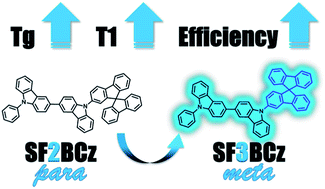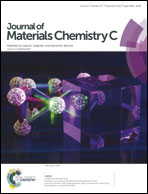Improved host material for electrophosphorescence by positional engineering of spirobifluorene–carbazole hybrids†
Abstract
Two novel materials, SF2BCz and SF3BCz, which combine spirobifluorene (SF) and carbazole units by meta- and para-bonding, have been designed and synthesized by a straightforward process as hosts in phosphorescent organic light-emitting diodes (PhOLEDs), and their thermal and electronic absorption and photoluminescent properties investigated. The meta-linkage of SF enables SF3BCz to possess high triplet and energy levels and good thermal stability. Blue PhOLEDs featuring SF3BCz as a host give high performance and low roll-off, with an efficiency of 41.4 cd A−1 (39.8 lm W−1) at 100 cd m−2 and 39.7 cd A−1 (29.8 lm W−1) at 1000 cd m−2. In addition, SF3BCz has been adopted as a universal host for white PhOLEDs, with a maximum external quantum efficiency of 21.3% for two-color and 19.8% for three-color-based white devices. By adopting tandem technology, a four-color-based white PhOLED was also successfully constructed, achieving 40% external quantum efficiency and a stable color spectrum.


 Please wait while we load your content...
Please wait while we load your content...